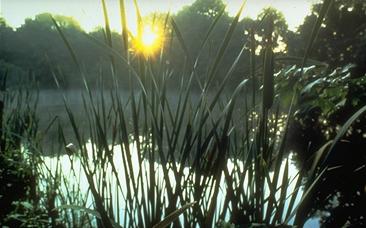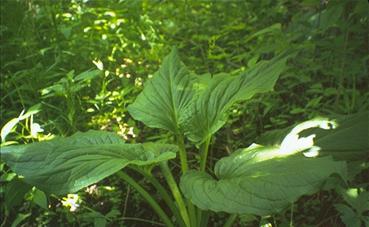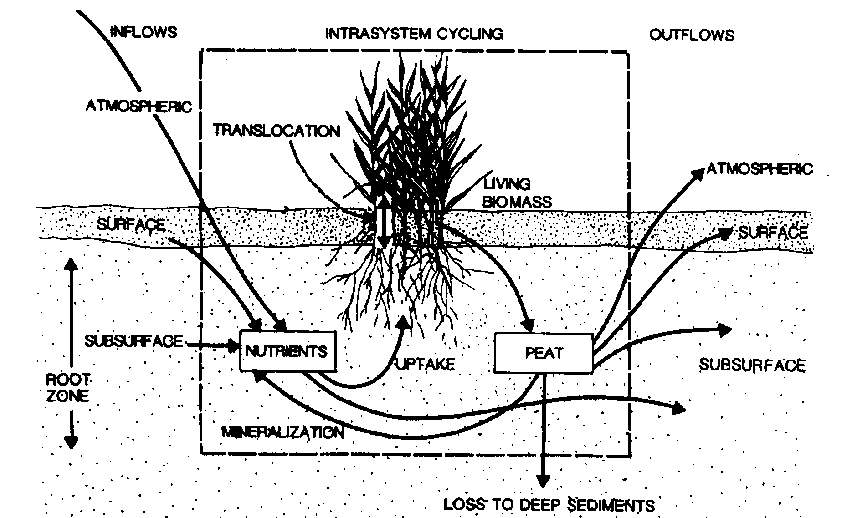


Water Quality Improvement
Wetlands help maintain good water quality or improve degraded waters in several ways:
- Nutrient removal and retention,
- Processing of chemical and organic materials, and
- Reduction of the sediment load of water.
Nutrient Cycling: Addition, Removal and Transformation
Water may enter a wetland by means of surface inflow, ground water discharge or tides and be discharged with improved quality as a result of passing through the wetland. Nutrients are carried into wetlands by hydrologic pathways of precipitation, river flooding, tides, and surface and ground water inflows. Outflows of nutrients are controlled primarily by outflow pathways of waters. The inflow and outflow of water and nutrients are important processes that effect wetland productivity.
Wetland processes remove suspended and dissolved solids and nutrients from surface and ground water and convert them into other forms, such as plant or animal biomass or gases. Debris and suspended solids (fine sediment or organic matter) may be removed by physical processes, such as filtering and sedimentation.
Toxics Retention
Hydrophytic vegetation (adapted to live in water) and microbial activity help remove toxic substances and excess nutrients from surface water. Nutrients, dissolved solids and other constituents may be removed or degraded, such that they become inactive, or incorporated into biomass. This occurs through adsorption and absorption by soil particles, uptake by vegetation and loss to the atmosphere through decomposition and exchange between atmosphere and water.
Biologic inputs to wetlands include photosynthetic uptake of carbon, nitrogen fixation, and biotic transport of materials by mobile animals such as birds and small mammals. Geologic inputs include elements derived from the weathering of parent rock which are often transported to wetlands in surface and ground water. Other hydrologic inputs include elements derived from air pollution which are delivered to wetlands by precipitation.
Sediment Reduction
Wetlands along rivers, streams and coastal areas are important for removing sediment from surface and tidal waters. During large flood events, rivers frequently overtop their banks and water flows through adjacent floodplains and wetlands. Flood waters carry large volumes of suspended sediment, mostly fine sand, silt and clay. Because floodplains and wetlands provide resistance to flow - from dense vegetation, microtopography, and woody debris - the flow of water is slowed and sediment is deposited and stored in these areas. Similarly, coastal marshes and estuaries retain sediment brought in by tides and residual suspended sediment from rivers.
Regional Factors Effecting Water Quality
As water passes through the water cycle - precipitation, evaporation and evapotranspiration- its mineral content changes as a result of processes that occur in air, water and earth. The variability in concentrations of chemicals (dissolved ions) in runoff, streamflow and ground water that enter wetlands is caused by several factors (from Mitsch and Gosselink, 1993).
Groundwater Influence. The chemical characteristics of water depend on the degree to which the water has come in contact with geologic formations (rock units) and on the types of minerals present in those formations. Chemical and physical weathering of soil and rock, through dissolution and redoc reactions, provides major dissolved ions to waters that enter the ground.
Climate Effects. Climate influences surface water quality through the balance of precipitation and evapotranspiration. Arid regions tend to have higher concentrations of salts in surface waters than do humid regions due to higher rates of evaporation. Climate also has a considerable influence on the type and extent of vegetation on the land, and it therefore indirectly affects the physical, chemical, and biological characteristics of soils and the degree to which soils are eroded and transported by surface waters.
Geographic Effects. The chemistry of water entering a wetland also depends on the size of the watershed, the slope of the landscape, soil texture, and topographic variations. The presence of upstream wetlands also influences the quality of water entering downstream wetlands.
Streamflow and Ecosystem Effects. The water quality of surface runoff, streams and ground water varies seasonally. During periods of high precipitation, surface water is delivered to wetlands rapidly and therefore has fewer dissolved minerals. During dry periods, ground water contributes largely to streams and wetlands, generally increasing the concentration of dissolved minerals in the water.
Human Effects. The modification of surface water through human activities often drastically alters the chemical composition of stream flow and ground water that reach wetlands. Drainage from agricultural fields often have increased concentrations of sediments, nutrients (nitrogen and phosphorous) and some herbicides and pesticides. Water drainned from urban and suburban areas may have high concentrations of trace organics, certain toxics (heavy metals, petroleum products) and nutrients from lawn and garden fertilizers.
Wetland Chemistry
The sum of all inputs, outputs and internal cycling of materials in an ecosystem is called the ecosystem mass balance. The ecosystem mass balance for wetlands includes materials from the three major components of wetlands: hydrology (water), hydric soils (nutrients), and biota (nutrient cycling). The diagram below illustrates the interaction between the three major components of the wetland mass balance (from Mitsch and Gosselink, 1993).

Sources:
A Method for the Assessment of Wetland Function, Fugro East, Inc., 1995, for Department of
Natural Resources.
Wetlands of Maryland, Tiner and Burke, 1995, for U.S. Fish & Wildlife Service and
Maryland Department of the Environment.
A Comprehensive Nontidal Wetland Watershed Management Plan: A Guide for Local
Governments, Clearwater et al., 1998, for Maryland Department of the Environment.
Wetlands, Mitsch and Gosselink, 1993, Van Nostrand Reinhold, New York, 722p.